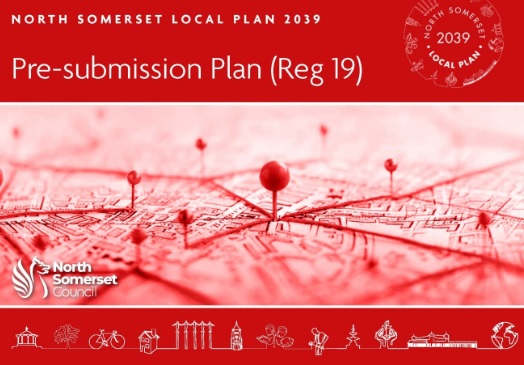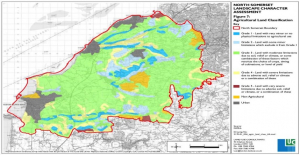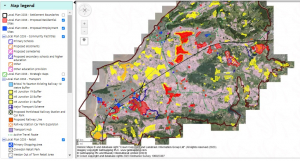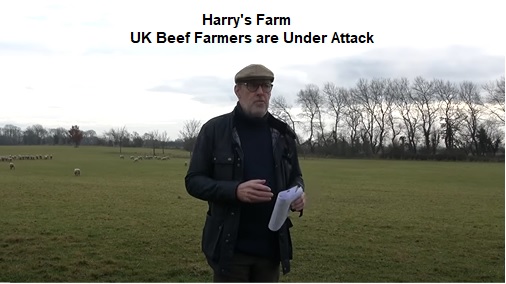
WHERE IS ALL THE AGRICULTURE LAND GOING... GOING... GONE?
UPDATE 19NOV24 - Report to the Placemaking, Economy and Planning Policy and Scrutiny Panel (PDF)
- "The local plan will have a potentially significant effect on communities living and working in the whole council area.
- Recommendations It is recommended that the Panel:
- 1. Endorses the sequential approach to the identification of additional development sites.
- 2. Considers the proposed approach and makes any recommendations to Executive Committee with regard to potential locations, issues and implications to consider."
UPDATE 31JUL24 - NSC Press Release delay of Local Plan (PDF) due to NPPF Consultation
UPDATE JUL24 - Draft Local Plan to Exec Committe with track changes
UPDATE 15JAN24: Local Plan 2039 Consultation presentation to 40-50 residents at the Youth Club
- Please support your rural community and post comments on NSC’s proposed Local Plan 2039
- Deadline 22 January 2024 - Consultation and associated documents here
- Especially Section 5 Countryside policy DP53 Best and most versatile land
- See all policies listed on pages 3-7, comment on any you feel passionate about
- NB: "The planning system entitles anyone to apply for permission to develop any plot of land, irrespective of ownership"
UPDATE 08JAN24:
Bleadon Parish Council (BPC) agree to host a resident meeting Monday 15 Jan 2024 Youth Club at 7pm,
This meeting is a direct result of the comments made by residents at the Annual Parish (Resident's) Meeting in April 23. In May 23 BPC noted,
"Concern was raised about North Somerset Local Plan Policy in relation to solar panels and wind turbines on agricultural land and its impact on farming. Suggestion that a Parish Meeting is held for the next Local Plan Consultation for the Parish Councillors to hear residents’ views." (Min 364.10) The place and time for this meeting were finalised by BPC at their meeting on Monday (Min 373.5). (NB It is an official resident's meeting hosted/chaired by the parish council)
Please support your rural community and post comments on North Somerset Council’s (NSC) proposed Local Plan 2039 by 22 January 2024 here, especially Section 5 Countryside policy DP53 (See letter to Town & Parish Councils and presentation to NSC Executirve Committee)
NB: North Somerset Council state,
"At the close of this consultation period the council will summarise the main issues raised by the representations and submit that summary to the Secretary of State. If the representations raise matters which would suggest changes should be made to the Local Plan before the document is submitted the council will consider the appropriate way to proceed. The examination is expected to take place in summer 2024. This will be followed by the report of the inspector. If the document is found to be ‘sound’ by the inspector it is expected that the Local Plan will be adopted by the council in December 2024 at the earliest... The right to appear or be heard at the examination is limited to those persons who make representations seeking a change to the plan at this stage” (See Local Plan p2 & p10)
NSC Local Plan Guide (PDF) states that, “this consultation is a bit different to the previous three consultation stages in that the Government asks you to consider (Planning and Country Planning Act 2004 s20 as amended) whether the Local Plan policies are:
- Compliant - does the plan meet the legal requirements made under various statutes?
- Sound - has the plan been positively prepared, is it justified, effective, and consistent with national policy?
- Meet the Duty to Cooperate - has the council engaged and worked effectively with neighbouring authorities and statutory bodies? This means that specifically, we (NSC) are asking people to consider whether the policies and proposals in the Plan meet any of these tests when making a comment.”
| Consultation | Opens | Closes | Information | |
| 27 Nov 23 | 22 Jan 24 at 5pm | "Representations made at this stage will be submitted to the Planning Inspector appointed to oversee the examination and will be made public" Local Plan 2030 Pre-Submission Document (300 page PDF) & 53 supporting documents |
NSC Current Interactive Local Plan Policies Map
NB: Previous 'Renewable Search Areas' of Local Plan Solar and wind mapping has been removed?
| Agriculture Land Classifications vs NSC Local Plan solar, wind, housing, etc. proposals on that land | |
Agriculture Land Classifications in current Solar PV SPD 2013 p34. See also NSC GI Strategy Fig16 | Solar, housing, etc. Local Plan 2038 mapping . compared to no current Local Plan 2039 mapping? |
Not all farmers are land owners. Those that are not landowners depend on their landlords to continually extend their leases, so that they can continue to farm. The actual land owners could live in the community, another part of the country, even abroad, using the land for investment purposes (e.g. in 2018 Bristol Airport was majority majority owned by Ontario Teachers’ Pension Plan Canada!)
| NSC and TOWN & PARISH LOCAL PLAN CORRESPONDENCE | |
| DATE | TOPIC |
19DEC23 &
| Request for support for farming to all NSC Town & Parish Councils |
| Presentation at NSC Executive Committee Regarding concerns over Farming, Food Production and Food Security |
30NOV23 incl Farm Video
| NSC Transport, Climate and Communities Policy and Scrutiny Panel |
| Biodiversity Net Gain (BNG) SPD Consultation responsebio |
| Draft Rural Strategy Considerations (still unpublished by NSC, draft due end of Jan 24) |
| Previous BOB Local Plan presentation and April 2022 Consultation submissions |
HOW IS NSC AND ITS POLICIES STRATEGICALLY ASSESSING AND PROTECTING FOOD PRODUCTION AND FOOD SECURITY IN NORTH SOMERSET?
- Why is farming, food production and food security NOT a NSC Corporate Plan priority or 'ambition'? (See NSC Corporate Action Plan Land Use and related blog)
DEFRA Agriculture in the UK Evidence Pack September 2022 update (PDF)
- "20% of England’s sheep herd is in the South West
- 39% of England’s dairy herd is farmed in the South West.
- The West Midlands has the smallest average farm size compared to the average for England, closely followed by the South West [so if small farms are encouraged to diversify e.g. solar, BNG, nature recovery, housing, etc. food production and security will be affected]
- In 2020, after deductions for wages, rent, interest and asset depreciation and taking subsidy contributions into account, the total income from farming in England was £3.6bn, with the South West contributing the most (19%) and the North East the least (4%).
- Since 1988, the amount of food consumed in the UK of UK origin has fallen from 66% to 58% and the amount of food consumed of EU origin has risen from 18% to 23% over the same period. However, food of UK origin rose 4% and food from EU origin decreased 5% in 2021 compared to 2020.."
- Farming and environment evidence packs - latest editions
(p177) Policy DP43: housing (including rural exception schemes)
- "Developments will be expected to provide 38.5% affordable housing on greenfield sites and 20% on previously developed land.." How will food production land be protected?
NSC defintion "Sustainable development: Development which meets the needs of the present generation, without compromising the needs of future generations to meet their own needs." (Glossary) NSC policies need to protect the future of farming, food production and securtiy for future generations.
(Page 98) Local Plan Policy DP7 Large scale renewable and low carbon renewable energy
- NSC definition "Renewable energy: Energy generated from the sun, the wind, water and plant material (biomass)."
- "Proposals for energy generation from renewable and low carbon sources including wind turbines, solar photovoltaic arrays, biomass and hydropower (marine, river and tidal) schemes will be supported subject to no unacceptable impact on: (a variety of caveats including) ..."Infrastructure assets including power lines, roads, rail and aircraft safety." Food is one of the government's 13 Critical Infrastructure Sectors, NSC's policies do not appear to reflect this status, however, "On greenfield sites, all proposals should seek to support continued agricultural use and biodiversity improvements"
- "Proposals for biomass/bioenergy developments will be approved provided they are of a scale and type which is appropriate to the location" "NSC definition "Bioenergy: Energy that is made from biomass or biofuel. Biomass: Organic material of biological origin (plant or animal), used as fuel to produce electricity of heat. This will include wood, energy crops or animal waste from farms." (Glossary) Biomass/Bioenergy production should not replace food production for people and animals.
- "North Somerset Wind Energy and Solar PV Supplementary Planning Documents will be updated to highlight potential locations identified as most technically suitable areas for renewable energy schemes from the Renewable Energy Resource Assessment Study (2021)." NSC Solar Photovoltaic (PV) Arrays SPD 2013 pg32 image pg34 image and Wind Turbines 2014.
- How are ethical and environmental issues to be addressed e.g. production (mining slave and child labour/health & safety, use of coal powered stations, etc.), shippping (carbon miles), decommissioning (landfill & other environmental issues)
- Where are these updated documents published? Why are these important documents not updated and referenced during this consultation? Are these SupplementIary Planning Documents(SPD) the same as the published 'Landscape Sensitivity Assessment Solar PV and Wind Energy' Document?
- NB Independent analysis of the carbon emissions associated with new nuclear plants have demonstrated they have smaller lifetime greenhouse gas footprint than that created by solar power and about the sam"e as wind power. It also operates 24/7, not just in the daytime or on sunny or windy days." (EDF and IPCC)
"The SPD will also provide guidance in relation to the Landscape Sensitivity Assessment (2021), which assessed the landscape sensitivity of different parts of North Somerset in relation to solar PV and wind turbine development." Current version in consultation is Landscape Sensitivity Assessment Solar PV and wind energy development NOV 23,
- C.67 "LCA G1 has a lower landscape sensitivity to solar PV developments as it has a greater sense of visual enclosure provided by the gently undulating landform and surrounding woodland and mature hedgerow boundaries."
- C.68 "LCA G2 has a slightly higher sensitivity to solar PV developments due to its more open character with low hedgerows, and the high frequency of seminatural habitats and historic features..." (pg 140)
"For some uses it may be possible to return the land to productive agricultural use without any loss of quality, should the proposed use no longer be required. For example, solar farms or similar. Suitable measures will be put in place to ensure this could be achieved." What suitable measures can be put in place? (See mega solar developments in Langford)
(p204) NSC Local Plan DP53 Best & Most versatile land states,
- "The proportion of Grade 1 land in North Somerset is approximately 7% and 10% for Grade 2. 60% falls in Grade 3..." How much of this land is already in use as food production for people and animals, regardless of whether it is 3a or 3b, the latter seemingly a target for solar, housing, nature recovery, BNG, etc.? Note that the 3b land classification is said to be ‘moderate quality agriculture land’, not poor or useless, and has a role in current farming (See Langford Mega-Solar Development on grades 3b and 4 agriculture land) and mega-solar project maps on BOB. No mention of 3b or quantification of the area of land involved?
(p205) Local Plan DP54 Rural Workers Housing
- "Farmers are encouraged to diversify their activities and supplement their income from enterprises other than normal food production."
- What is being done to protect or 'offset' the land for the existing food production and food security? What is NSC doing to improve this locally?
(p91) Policy DP5 Climate change adaptation and resilience
- "Protect spaces for local food production and market gardening including allotments, tree planting, community orchards, community gardens and identify opportunities for community composting"
- "A Supplementary Planning Document (SPD) will be prepared to set out the detail for how these policy requirements will be implemented."
- Where is the detail of this document? Will it include protecting farming?
(p93) Local Plan DP6 Net Zero Construction READ THIS POLICY IN DETAIL
SEE GOVERNMENT ENERGY BILL - "...under this new legislation, those who fail to adhere to energy consumption regulations could face imprisonment for up to a year and fines of up to £15,000"
Good God! Is Britain really going to jail people who disagree with net zero?
- "... getting design right from the outset is much more cost effective than needing to retrofit later. The report recommends a space heating demand of 15-20kWh/m²/year by 2025 at the latest. ...guidance on meeting net zero recommends a maximum total energy use of 35 kWh/m²/year" What if you use more?
- "Renewable Energy Offsetting Residual energy demand should be met through the generation of onsite renewable energy, but if this is not technically feasible, the requirement may be met elsewhere by means of offsite renewable energy generation." What is NSC's expectations for old/ residential and non-residential buildings?
- "Renewable energy offsetting must only be used where it is demonstrated as not technically viable to meet the residual energy demands through onsite renewable energy generation. This is to ensure that new buildings are as energy efficient as possible and will not need retrofitting in the future. The council has a renewable energy offset scheme. Renewable energy credits will be purchased in order to achieve the net zero energy balance. This will be an agreed cost per kWp or per kWh generated, to meet the net annual energy demand for a scheme.The price per kWh generation shortfall will be agreed at planning application stage. An update to Creating Sustainable Buildings and Places Supplementary Planning Document will set out the process for securing offset credits, where these are required"
- "A building’s energy use is now considered to the best measure for net zero compliance, whilst reducing emissions on-site is no longer the best measure of sustainable design. Total energy use and space heating metric targets are considered to be the best mechanism to model and monitor net zero compliance because the electricity grid is decarbonising. One of the key advantages is that these metrics can be checked once the building is occupied without requiring further modelling or analysis."
- Local Plan Glossary re: Absolute Net Zero and Net Zero Operational energy and Net zero whole life carbon building and Net zero embodied carbon building and Net Zero Energy Standard: How will NSC treat old buildings with regards targets and offsets? How much of this 'off-site' renewable energy will use food production land?
Carbon offsetting report – 'Carbon offsetting within an energy intensity policy framing Report to West of England Authorities Final' 30 June 2022
- "Prioritising rooftop solar would minimise the use of agricultural land for solar development and the associated landscape and other impacts. This is likely to align with understandable public and political opinion that we should prioritise rooftop installations ahead of greenfield solar."
- "... there are legitimate trade-offs between the use of roof-space for renewable energy generation to get to a net zero operational balance, and the use of limited roof space to meet policy requirements around climate adaptation, for instance for green roofs to provide habitat and mitigate overheating or the provision of roof gardens or amenity space for residents. This might mean that in inner urban areas where overheating is likely to be a greater concern, authorities place a greater emphasis on climate adaptation considerations and accept slightly greater use of off-site renewable energy to achieve a net zero operational balance." (30JUN22- updated 17NOV23)
- Does this mean NSC policies put greater emphasis on 'climate adaption' rather than on food production and security? Will inner urban areas, that have little/no open land, be looking to use rural NSC countryside to achieve their chosen net zero targets? How does NSC intend to protect agriculture and 'offset' food production and security?
PDF of Further Policy Comments
NSC Strategic gaps Background Paper NOV23 (PDF)
"...., the relatively sensitive nature of the landscape, taking account of the topography and views, would suggest that if significant development was proposed there could well be a landscape reason for refusal." So how does this fit with potential solar panels over Bleadon fields? Does NSC's definition of development include business (caravan) and energy related development, or just housing?
SOME NSC Budget Info1 and Budget Info2 (06DEC23)
- RURAL FINANCING
- REPF - Grants to Rural Business £106,229 in 2023/24 and £159,342 in 2024/25
- REPF - Grants to Rural Communities £70,817 in 2023/24 and £106,229 in 2024/25
- Addition - Rural England Prosperity Fund - DP566 £177K in 2023/24 and £266K in 2024/25
- Decarbonisation of heat (boilers) £1.8 million (Grants & Contributions)
- Decarbonisation at Campus £1,197,000 (£886K Grants & Contributions + £311K Capital Receipts)
- Eco Bus (library outreach vehicle (mobile replacement) £175K (Borrowing)
- Office for Low Emission Vehicles (OLEV) £212,508 (Grants & Contributions)
- Low Emission Vehicle Provision - Match (grant to be added once known) £45K Borrowing)
- Purchase of Vehicles - Place (Electric vehicles?) £548,597 (£351,332 Borrowing + £123,266
- Waste & Recycling - vehicles and electric vehicle top-up £12,352,595 (Borrowing)Reserves & Revenue + £74,000 Capital Receipts)
- Environmental Services & Safer Communities - overspend of £1.423m
- Purchase of Land to support biodiversity net gain £300K (Borrowing)
- Land for Yatton Secondary £2 million (Grants & Contributions)
- Land at Parklands Village £384,527 (Grants & Contributions)
- Land Release Fund - Churchill Avenue, Clevedon £350K (Grants & Contributions)
- Land Release Fund - Uplands, Nailsea £481,020 (Grants & Contributions)
-
- NSC faced "... a £50 million budget gap between now and 2028 - but since then, they've narrowed that to just £13 million. Just under £4 million of that ne eds to be found for the next financial year."
- "At this time the council expects to receive £314.625m of grants and contributions from external stakeholders to fund specific schemes, which is the largest component of the programme, although the council will need to borrow £111.132m in order to be able to deliver all aspects of the programme." Budget Info2
CAPITAL PROGRAMME BORROWING Adult Social Service £0 Childrens Services
£5,559,624 Housing
£421,498 Corporate Services
£13,491.998 Place
£91,659,010 TOTAL
£111,132,130 - How much of this debt is attributed to NSC declared climate crisis, nature crisis and environmental related projects?
- How much public land has NSC sold and for what purposes?In particular, how much smallholding land has been sold, and what effect has this had on farming?
- The total area of NSC smallholdings land as at 31 March 2022 amount to 166ha (410 acres). S See Langford solar developments.
- NSC faced "... a £50 million budget gap between now and 2028 - but since then, they've narrowed that to just £13 million. Just under £4 million of that ne eds to be found for the next financial year."
European Commission - Grazing for Carbon (10MAY17)
"The potential of grasslands as a sink for carbon is enormous in Europe"
What is NSC's plan for meat in the future, will local people rather than political party 'green' politics direct NSC decsion making? (See C40 Mayors Dietary Plan)
---
See also:
and related info
- NSC Climage Emergency
- NSC Nature Emergency and Declaration (PDF)






Make A Comment
Comments (0)